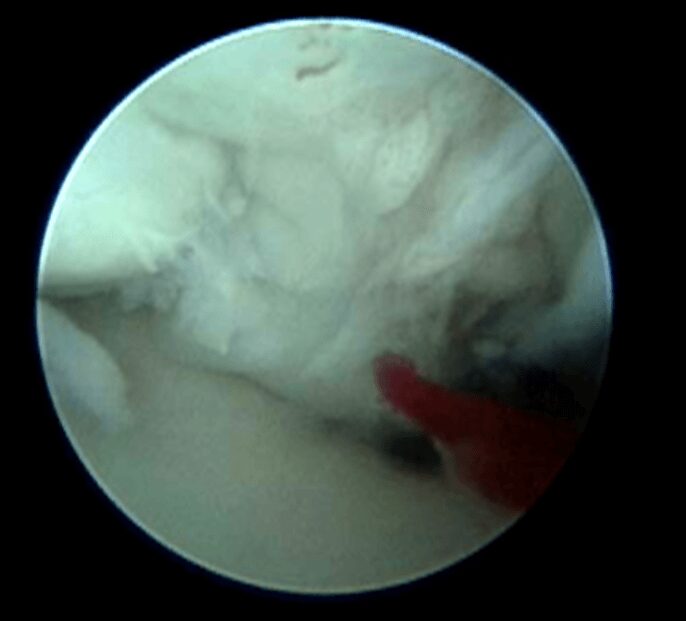Veterinary Orthopedics and
Arthroscopic surgery
Arthroscopic surgery in companion animals is the most important advancement in veterinary orthopedics since the introduction of bone plating techniques.
Since its early development in the late 1980s, arthroscopy in veterinary patients has dramatically changed the routine management of many conditions of the shoulder, elbow and stifle.
Arthroscopy can also be performed in the hip, tarsus and carpus, but these procedures are less common. Additionally, arthroscopy has allowed us to identify some new intra-articular conditions and has greatly advanced our understanding of other conditions. This article is written with the intention of highlighting the unique capabilities of this powerful tool and to assist veterinarians in counseling their clients on what to expect when referring a pet for arthroscopic surgery.
Conditions of the elbow joint
Arthroscopic procedures of the elbow are among the most common arthroscopic procedures performed. Arthroscopy is indicated for fragmented medial coronoid process (FMCP), osteochondritis dissecans (OCD) of the elbow, ununited anconeal process (UAP), and exploration and synovial biopsy of the elbow for diagnostic purposes.
By far the most common indication is the fragmented medial coronoid process. Arthroscopy for FMCP allows for more complete exploration of the joint, more rapid recovery, and easy retrieval of the coronoid fragment. In most referral hospitals, elbow arthrotomy for FMCP is largely obsolete because of the additional trauma to the joint and morbidity associated with the open procedure. While approximately two-thirds of patients show significant improvement after FMCP surgery, no procedure appears to change the long-term prognosis for this disease with all dogs developing progressive osteoarthritis over time.
Arthroscopy is still worthwhile in younger dogs (<1.5 years) as it does appear to provide comfort. Unfortunately, the benefits of arthroscopy appear to diminish with age, although there is no upper limit of when the surgery can be done. Arthroscopy continues to improve our understanding of this still poorly understood disease.
Arthroscopy for elbow OCD is performed similarly to the procedure for FMCP and allows for easy removal of the cartilage flap generally located on the medial portion of the humeral condyle. Fortunately, true elbow OCD is not very common as this process carries a poorer long-term and short-term prognosis than FMCP because of the development of severe osteoarthritis.
Arthroscopy for UAP generally is performed to rule out concurrent FMCP and to evaluate the overall health of the joint prior to ulnar ostectomy or repair of the anconeal process. The UAP fragment is much too large to remove arthroscopically and if removal of the fragment is chosen, it should still be removed through a caudolateral arthrotomy.
Arthroscopy of the shoulder
Arthroscopy of the shoulder is indicated for shoulder OCD, biceps tendon injury, medial shoulder OCD of the shoulder is readily treated using arthroscopy and has, for most surgeons, replaced shoulder arthrotomy. Arthroscopy offers

Normal Biceps Tendon In The Shoulder
much better visualization of the shoulder along with rapid return to excellent function. As with the elbow, bilateral procedures are common and dogs often go home the same day as the surgery. OCD of the shoulder has an excellent long-term prognosis.
Older dogs with chronic shoulder pain often are diagnosed with either bicipital tendon injury (tenosynovitis) or medial shoulder instability. Medial shoulder instability is characterized by partial tearing of the medial glenohumeral ligament and/or subscapularis tendon. These two conditions are very difficult to distinguish on physical exam although a skilled musculoskeletal sonographer can often help narrow the diagnosis. Bicipital tendon injuries are easily treated arthroscopically by simple transection of the biceps tendon (biceps tendon release).

Partially Torn Biceps Tendon
Unfortunately, medial shoulder instability is easily diagnosed using arthroscopy but not so easily treated. Treatment for this condition includes medical management and/or open shoulder stabilization procedures. Generally medical management is exhausted first including pain management and intra-articular injections. The long-term prognosis for medial shoulder instability is guarded for return to normal function.
Arthroscopy of the stifle
Indications for stifle arthroscopy include debridement of the stifle joint during cranial cruciate ligament surgery, evaluating and removing damaged menisci, debridement of stifle OCD and exploration and synovial biopsy of the stifle.
Arthroscopy may be used in conjunction with TPLO or other stifle repair techniques or to debride late meniscal tears in dogs that have already had stifle surgery. Arthroscopy allows a thorough examination of the joint, however, the infrapatellar fat pad makes the stifle the most difficult joint to gain good visualization. With practice, arthroscopic debridement of the CCL remnants and partial meniscectomy can be performed with confidence.
Stifle OCD is a relatively uncommon disease that is often operated on arthroscopically. The loose cartilage flap generally occurs in the lateral femoral condyle and unfortunately leads to a large defect in the cartilage surface. Because of the high morbidity associated with this disease, some surgeons recommend cartilage replacement procedures to allow the dog to have a more normal joint surface.
Conclusions
Arthroscopic surgery has become state-of-the-art for many intra-articular procedures and represents a major step forward to veterinary orthopedics. Clients love the fact that their dogs will recover more rapidly and experience less pain after their surgical procedure. Most dogs with arthroscopic procedures can go home the same day as the procedure and are able to walk on the operated leg right away. Since these procedures are minimally invasive, infections and other complications are rare.


